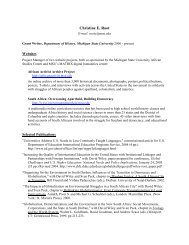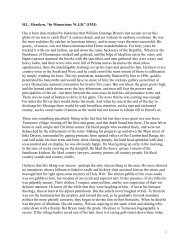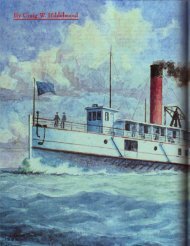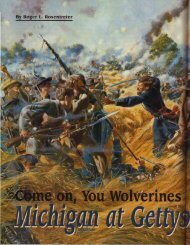manga - MSU Dept of History
manga - MSU Dept of History
manga - MSU Dept of History
- No tags were found...
You also want an ePaper? Increase the reach of your titles
YUMPU automatically turns print PDFs into web optimized ePapers that Google loves.
INTERNATIONAL COMICSbritain, canada, mexico, france, india, japan (and beyond)1
MANGAirresponsible pictures2
<strong>manga</strong> - irresponsible pictures/whimsical picturesnowhere else in the world (Japan) do comics appeal to a wider audience or achieve greaterfinancial successManga widely targeted at extremely diverse audiences:Shōnen <strong>manga</strong> - targeted at young male audience (10-18 yrs)Shōjo <strong>manga</strong> - targeted at young female audience (10-18 yrs)Seinen <strong>manga</strong> - targeted at an adult male audienceJosei <strong>manga</strong> - targeted at an adult female audienceKodomo <strong>manga</strong> - targeted at children3
MANGA vs. COMICSThere exists some noteworthy differences between <strong>manga</strong> and western comics:Lower Production Values - <strong>manga</strong> is almost always published in black & white on muchlower quality paperScope - Manga is usually published as anthologies <strong>of</strong> several hundred pages. Eachpublication may contain several serialized features.Style - <strong>manga</strong> is intended to be read very quickly7
HISTORICAL ROOTS OF MANGAirresponsible pictures?8
HOKUSAI MANGA1812 - Hokusai published the first volume <strong>of</strong> his <strong>manga</strong> - QuickLessons in Simplified Drawingetehon (art manuals) - a convenient way to make money andattract more studentsdrawings <strong>of</strong> animals, religious figures, and everyday people -<strong>of</strong>ten with humorous overtones15 volumes published (12 during his lifetime & 3 posthumously)10
STORYTELLING MANGAlittle red books14
The <strong>manga</strong> magazine publishing boom started with the Russo-JapaneseWar (1905)The <strong>manga</strong> industry (as a storytelling medium) really took hold in Japanuntil after World War II - escapist litteraturePost World War II - Japanese pay libraries.Cheap “red books” (so-called because <strong>of</strong> the gaudy red ink used on thecovers) became staples <strong>of</strong> these vendors15
OSAMU TEZUKAOsamu Tezuka (1928 - 1989) - defined the modernmedium (language, storytelling techniques, form, etc.)Took inspiration from animated films <strong>of</strong> Fleischer Studiosand Walt DisneyTezuka’s success made is acceptable for serious artiststo work as pr<strong>of</strong>essional <strong>manga</strong> creators - <strong>manga</strong>ka16
MANGA IN THE WESTChallenges to bringing <strong>manga</strong> to the west:Design differences - Japanese read from right to left instead <strong>of</strong> left to right.Production problems - switching to a left/right flow results in printing and compositionissuesCultural conventions - cultural idiots represented certain barriers to easy interpretation22
Lone Wolf & Cub (1987) - reprinted by First ComicsKazuo Koike & Goseki Kojima - 7000 page epicbeginning 1970series about a ronin who brings his baby son, the onlysurviving member <strong>of</strong> his murdered family, on a quest forvengeance upon those who framed himFrank Miller contributed covers (and an introduction in thefirst issue)23
Akira - Katsuhiro OtomoStarted in 1982 (published in Young Magazine)Ran for 8 years and reached more than 2000pagesStory <strong>of</strong> young psychics and bikers living in apost-apocalyptic TokyoOtomo directed an anime version in 1988 -attracted attention because <strong>of</strong> its high productionvalues.25
FRANCO-BELGIANbande dessinée26
The French and Belgians have always embraced the comics medium as artClaude Beylie (French film scholar) argued that comics deserved to be held as the “ninth art”putting it on even footing with television and seven other arts by Italian film critic RicciottoCanudoIn the Franco-Belgian tradition, comics are bande dessinée (“drawn strips”) - also referred toas BDStripverhalen (“strip stories”) in Dutch27
HERGÉGeorges Prosper Rémi (1907 - 1983) - used the pen name HergéDebuted on January 10th, 1929 in the Belgian newspaper LeVingtième Siècle as part <strong>of</strong> the youth supplement (Le Petit Vingtième)Catholic and conservative newspaper from Brussels, led by abbotNorbert WallezPublished a series <strong>of</strong> other (less popular strips) in the pages <strong>of</strong> LePetit Vingtième29
Tintin in the Land <strong>of</strong> the Soviets (originally knownas Les Aventures de Tintin, reporter du Petit"Vingtième", au pays des Soviets)Published in 1930Political satire - expressing Hergé's distrust <strong>of</strong> theSoviet Union and poking fun at its claim to have athriving economyBolsheviks are represented as the villains (atheists)Hergé used Moscou Sans Voiles (MoscowUnveiled) written by Joseph Douillet, a formerBelgian consul in Soviet Russia32
ASTERIX & OBELIXwild and crazy gauls35
RENÉ GOSCINNYRené Goscinny (1926 –1977)Served in the French army, and eventually became theillustrator for the 141st Alpine Infantry BattalionCollaborated with Albert Uderzo on a series <strong>of</strong>projects including Oumpah-pahLaunched The Adventures <strong>of</strong> Asterix as a strip in Pilot(French comics periodical) in 195936
BANDE DESSINÉE ALBUMThe successful reception <strong>of</strong> strips like Tintin and Asterix led to an important development inthe solicitations <strong>of</strong> bande dessinée - the albumhardbound collections <strong>of</strong> strips - encouraged the idea that the bande dessinée werekeepsakes worth reading instead <strong>of</strong> disposable ephemeraalso helped nurture the pr<strong>of</strong>essional standing <strong>of</strong> creators nd fostered a favorable repute for theburgeoning industry38
The album system <strong>of</strong> bande dessinée publication prospered because:1. Creators were paid both for their serialized work appearing in periodicals as well asroyalties from the album reprints - it became possible to make a living being a creator2. Copyright laws protected a creator’s ownership <strong>of</strong> a character or a strip, so theagreement to have a publisher print (or reprint) a strip was not tantamount tosurrendering ownership <strong>of</strong> the IP3. Because a creator could make their living at their pr<strong>of</strong>ession and they were always linkedto their creation, fame and notoriety began to emerge around the most talented creators39
COMICS REVIEW BOARD1949 law establishing a review board for the censoring <strong>of</strong> French comics (reacting to the flood<strong>of</strong> imported comics flowing into france after WWII)The law resulted in an unlikely alliance between Catholic educators and the Communist PartyBoard set limits on the amount <strong>of</strong> material that could be imported for publication - forcedpublishers to rely on native talentBoard was undermined in the 1960s as the French counterculture movement turned theirattentions outside <strong>of</strong> France - especially underground American comix (R. Crumb)40
MOEBIUSthe next generation <strong>of</strong> french comics41
Jean Giraud - Meobius (Gir)Came to prominence as the artists <strong>of</strong> theLieutenant Blueberry - published in Pilote(starting in 1963)co-founded Métal Hurlant - a horror and sciencefiction comics anthology magazine - laterfranchised in the U.S. as Heavy MetalLater work rejected traditional realistic depictionsin favor <strong>of</strong> Nouveau Réalisme1988 - collaborated with Stan Lee on SilverSurfer Epic Comics project42
CANADIAN COMICSstories from the great white north48
The Canadian comics industry is wrapped up in the country’s attempt to maintain a distinctnational identity (in the shadow <strong>of</strong> the United States)Distinct difference between the comic industry in French speaking Canada and Englishspeaking CanadaImport <strong>of</strong> U.S. comics into Canada started in the 1930sWar Exchange Conservation Act (1940) stopped the import <strong>of</strong> non-essential materials(including comic books)49
Maple Leaf Publishing - Better Comics #1 (1941)Other publishers soon followed and began <strong>of</strong>fering avariety <strong>of</strong> books: sports, humor, westerns, war,adventure, detective, and superheroSome publishers side stepped the War ExchangeConservation Act and publishedAnglo American - purchased Captain Marvel scriptsfrom Fawcett Comics and had Canadian artistsredraw them before publishing and distributing themin Canada50
Triumph-Adventure Comics #1 (Aug. 1941)Created by Adrian Dingle and published byHillborough StudioDemi goddess who protected the Inuit peopleFirst Canadian national superhero - one <strong>of</strong> the firstfemals superheroes (predates Wonder Woman byseveral months)52
CANADIAN COMICS IN THE WAKE OF THESECOND WORLD WARwartime protectionism could only keep American comics at bay for so longAs soon as the second world war ended, American comics flooded the country againBy 1947, the American publishing industry had reasserted itselfCanadian publishers might reprint American material, but no original Canadian material wascreated.56
THE CANADIAN COMICS RESURGENCEThe Canadian comics publishing industry saw a resurgence in the late 1960s and early 1970sThe result <strong>of</strong>:rise <strong>of</strong> fandom/cycle <strong>of</strong> domestic nationalismEmergence <strong>of</strong> the small press modelEmergence <strong>of</strong> the underground/alternative/comix scene57
Orb Nos. 2-5 (July 1974 – 1975); PowerComics No. 4 (Nov. 1977)Science fiction story - adventures on Mars, etc.Originally the creation <strong>of</strong> the writer T. CaseyBrennan and the artist John AllisonCharacter was later revamped by Orb publisherJames Waley and the artist James Craig.59
Captain Canuck - Originally developed by RonLeishman (later with Richard Comely)Self published by Richard Comely (under theComely Comix banner)First issue was published in July <strong>of</strong> 1975 -attracted much media attention (domestically andinternationally)Took place in the future (1990s) when Canada wasa superpower because <strong>of</strong> its natural resourcesCharacter worked for CISO (Canadian InternationalSecurity Agency)62
Cerebus the Aardvark - created by Dave SimSelf published by Aardvark-Vanaheim Press1977 - 2004; 300 issuesThroughout its run, book shifted from a sword andsorcery parody to a platform for socio-politicalcommentaryNegotiations regarding DC buying Cerebus took placefrom 1985 - 1988; DC <strong>of</strong>fered $100,000 and 10% <strong>of</strong>all licensing and merchandising, which Sim rejected.64
Sim became an outspoken advocate <strong>of</strong> creators'rights in comics, and used the editorial pages <strong>of</strong>Cerebus to promote self-publishing and greater artistactivismThe biggest individual supporter <strong>of</strong> the Comic BookLegal Defense FundEventually began to alienate many <strong>of</strong> his readers aswell as fellow creatorsLengthy prose sections (#186/#265) that areincredibly misogynistic & sexist - Sim identified a"feminist/homosexualist axis" that opposedtraditional and rational societal values65
THE MODERN CANADIAN CONTRIBUTIONcreatorspublishers66
HISTORIETASmexican comics67
Mexico has sustained a vibrant comics industry <strong>of</strong> its own despite the threat <strong>of</strong> AmericancompetitionHistorietas - little storiesThe success <strong>of</strong> historietas has to do with several factors:language barriersocial acceptance <strong>of</strong> graphic storytellingeconomic factorsstorytelling structurefan community68
ECONOMIC & LANGUAGE FACTORSGetting comics to Mexican publishers was a low priority for American publishers in the earlydays <strong>of</strong> comics1921 - editor <strong>of</strong> one Mexican newspaper (El Heraldo) commissioned a strip by a local artist(Salvador Pruneda) - story <strong>of</strong> a cowboy named Don Catarino.By 1934 newspaper publishers began collecting and reprinting stripsAmong the most popular were Paquin and Pepin69
STORYTELLING STRUCTURE & FAN COMMUNITYMexican audiences preferred ongoing episodic storytelling - which didn’t catch on in the U.S.market until the Silver Agecontinuing stories would encourage readers to return - developed “brand loyalty”Encouraged a sense <strong>of</strong> fan community: published reader letters, introduced creator pr<strong>of</strong>iles(developing a “star” system <strong>of</strong> cartoonists and writers), sponsored contests to engage readersTechniques later employed by Stan Lee at Marvel during the Silver Age70
MEXICAN COMICS CONTROVERSYDepictions <strong>of</strong> violence, sex, and non-traditional content (gender roles) raised the concern <strong>of</strong>more conservative segments <strong>of</strong> Mexican society - Catholic Legion <strong>of</strong> DecencyComision Calificadora de Publicaciones y Revistas Ilustradas (the Qualifying Committee forPublications and Illustrated Magazines) - 1944Review all comic titles and related publications once they were issuesWithin the omissions power to levy fines, revoke publishing licenses, and recommentprosecution for violation <strong>of</strong> decency laws71
LA FAMILIA BURRONGabriel Vargas - first published in 1948Drawn by Vargas from 1948 - 1971Follows a middle class family in Mexico CityMuch <strong>of</strong> the humor in La Familia Burron comes from classdistinctionsBurola (the wife <strong>of</strong> the family) attempts scheme after scheme toraise her middle class family up from the modest livingprovided by her husband’s barber salary72
KALIMANKalimam: El Hombre IncreibleBegan as a radio play in 1963First comic (created by Rafael Cutberto Navarro and ModestoVázquez González) was published in December 4, 19651200 issues were published (until 1991) - reprints have beenpublished since 1998.74
















